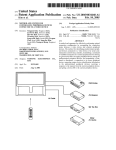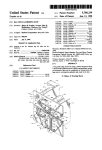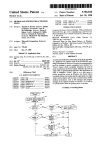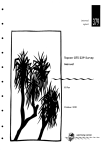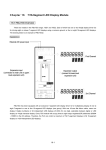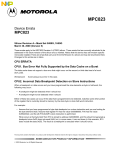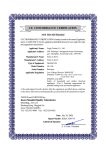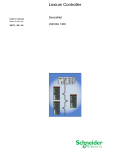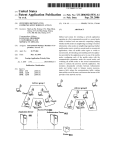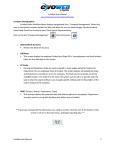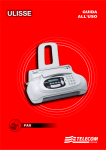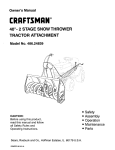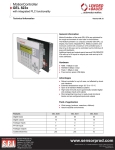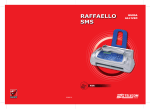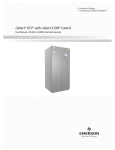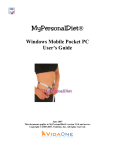Download I [secs
Transcript
IIIIII IIIIIII I| IIII III USOO5680323A III III III III III IIII IIIII III III III United States Patent 119] Patent Number: [45] Date of Patent: 5,680,323 [11] Barnard Oct. 21, 1997 Primary Examiner-Douglas W. Olms [54] MULTIMEDIA PLAYER Assistant Examiner?shick Hom [75] Inventor: John D. Barnard, Orange, Calif. Attorney, Agent, or Firm—Fitzpatrick, Cella, Harper & [73] Assignee: Canon Information Systems, Inc., Scinto [57] p [21] Appl. No.: 494,077 Costa Mesa, [22] Filed: A method and apparatus for launching a multimedia player from an operating windowing application such that the Jun. 23, 1995 multimedia player operates as a child window of the oper [51] Int. Cl.‘5 ................................................... .. G06K 15/00 [52] U.S. Cl. ................................ .. 364/514 A; 364/514 R; 395/153; 395/154; 395/157; 395/806 [58] Field of Search .......................... .. 364/514 A, 514 C, 364/514 R; 395/153, 154, 157, 165, 806; 370/1101, 522, 260 [56] References Cited U.S. PATENT DOCUMENTS 5,423,730 6/1995 Baker et a1. .......................... .. 395/154 5,457,780 10/1995 Shaw et a1. 5,539,871 5,539,886 ABSTRACT 395/165 7/ 1996 GibSOll ........ .. 395/ 154 7/1996 Aldred et a1. ......................... .. 395/153 ating windowing application. The method and apparatus operate to launch the multimedia player in response to a user-selection of a prede?ned function in the operating windowing application, identify a main window within the operating windowing application from which the prede?ned function was selected, locate, within the main window, a target child window having both a speci?c class-type and a speci?c dimension, create, in the case that the child window is located, a playback window and overlaying the playback window onto the target child window, and play, within the playback window, a multimedia selection corresponding to the user-selected prede?ned function. 35 Claims, 10 Drawing Sheets FIUN ‘TARGET‘ APPLICATION 8900 HAS HOT SPOT. HOT wono, 0R BUTTON BEEN SELECTED '_) r3919 TERMINATE MULTI-MEDIA PLAYER ($905 oPEN STAND-ALONE I WINDOW WITHIN CURRENTLY RUNNING APPLICATION CORHESPOND T0 ‘STAND ALoNE- MULTI-MEDIA w ¢ HUN ]’ MULTI-MEDIA S920 RETURN CHILD WINDOW HANDLE S907 S921 5911 SELECT'ON CREATE PLAYBACK WINDOW AND OVERLAY WINDOW OVER TARGET CHILD WINDOW LAUNCH MULTI-MEDIA PLAYER I TERMINATE SETEéEgIESKEJN COMPLETION AND [secs CLOSE WINDOW K 5912 LOCATE TARGET APPLICATION AND MAIN WINDOW FROM WHICH MULTIMEDIA PLAYER WAS LAUNCHED S922 i ENUMEFIATE AND IDENTIFY CLASS AND SIZE OF ALL ‘CHILD’ WINDOWS OPEN IN PARENT WINDOW 1 IMPLEMENT TARGET APPLICATION HOOK FUNCTION AND MONlTOFI WINDOW‘S MESSAGES SENT TO TARGET APPLICATION S923 RUN MULTI-MEDIA SELECTION V 916 TERMINATE MULTI-MEDIA PLAYER THERE A CHILD WINDOW WHICH MEETS PREDEFINED SIZE AND CLASS '7 TERMINATE MULTI-MEDIA PLAYER UPON COMPLETION OF MULTl-MEDIA SELECTION AND CLOSE PLAYBACK WINDOW US. Patent 0a. 21, 1997 TO FACSIMLE/OD Sheet 1 of 10 INTERFAC 5,680,323 US. Patent Oct. 21, 1997 5 95am Sheet 4 0f 10 5,680,323 mm _93c:5a02mP “ 2 EE 9 2: . 3 = 5 : 2 5 3 : 3 9 m 5 % 6 . 5 0 » 4 :0 S @ m5 5 E 3 . to . 0 05 2 5 5 B . B m 2 E c . i o : m “ a c w x 2 o m : u 3 t 5 o $ @ 5 3 8 2 ".E2532:@w2i5t03s-m5E ?N, 5:CxEu9:=32m;w9m8o0: E m .6 [email protected] i,5s58a25E E2m.530m .Q9. . US. Patent Oct. 21, 1997 Sheet 6 of 10 5,680,323 mm 95am _E59EE2:2:85:2. _mx52:9o.t5-2Fm0: "05we2530m2ik03e-m5Eh _53c:.2a3m. “mocBiEu5nc: _$932.°83 mo to.2:9B:E53. Bu2:=82m:w2m90o: _:0Sm2:E E. _Bag*0:maa3i5ns 5xm6: w m d @gE QG“ E2m13:50m 22%@WHM5?asE5#8“"52a:cm0w6. mom 6E@ US. Patent Oct. 21, 1997 Sheet 9 0f 10 ' 5,680,323 RUN "TARGET" APPLICATION 8900 $901 HAS HOT SPOT, HOT WORD, OR BU'ITON BEEN SELECTED '7 K. $905 OPEN STAND-ALONE WINDOW WITHIN CURRENTLY RUNNING T _ coggiséfa??biTEM 2321B APPLICATION WINDOW ? S907 RUN MULTl-MEDIA S911 SELECT'ON 1 LAUNCH MULTI-MEDIA PLAYER 8909 J??f?gi [ l LOCATE TARGET APPLICATION AND MAIN SELECTION UPON CLOsE WINDOW WINDOW PROM WHICH MULTI-MEDIA $912 l ENUMERATE AND IDENTIFY CLASS AND sIzE OF ALL "CHILD" WINDOWS OPEN K IN PARENT WINDOW $913 THERE A TERMINATE CHILD WINDOW WHICH MEETS PREDEFINED MULTI-MED'IA PLAYER sIzE AND CLASS 7 FIG. 9A @ US. Patent 0a. 21, 1997 K Sheet 1-0 of 10 5,680,323 S919 THAT CHILD WINDOW VISIBLE TERMINATE MULTI-MEDIA PLAYER S920 \— RETURN CHILD WINDOW HANDLE 8921 I K CREATE PLAYBACK WINDOW AND OVERLAY WINDOW OVER TARGET CHILD WINDOW S922 l IMPLEMENT TARGET APPLICATION K HOOK FUNCTION AND MONITOR WINDOW‘S MESSAGES SENT TO TARGET APPLICATION $923 I K S924 RUN MULTIMEDIA SELECTION l TERMINATE MULTI-MEDIA L PLAYER UPON COMPLETION OF MULTI-MEDIA SELECTION AND CLOSE PLAYBACK WINDOW FIG. 9B 5,680,323 1 2 MULTIMEDIA PLAYER BACKGROUND OF THE INVENTION from an operating windowing application such that the multimedia player operates as a child window of the oper ating windowing application. The method comprises the 1. Field of the Invention The present invention relates to a multimedia player steps of launching the multimedia player in response to a user-selection of a prede?ned function in the operating windowing application, identifying a main window within the operating windowing application from which the pre application which appears to be integrated and controlled by an operating windowing application from which the multi media player application was launched, all without having to modify the program of the windowing application, and, de?ned function was executed, locating, within the main window, a target child window having both a predetermined more particularly, the present invention relates to a multi 10 class-type and a predetermined dimension, creating, in the case that the child window is located, a playback window for windowing application has caused it to be launched and playing a multimedia selection and overlaying the playback plays a multimedia selection in a playback window which is window onto the target child window, and running, within overlaid onto a visible window which has both a prede?ned the playback window, a multimedia selection corresponding class-type and a prede?ned dimension of the operating to the user-selected prede?ned function. media player application which actively determines which windowing application. According to another aspect of the invention, the present 2. Description of the Related Art invention is a multimedia player which plays a multimedia Currently, there are many windowing application prod selection within an operating windowing application. The multimedia player comprises input means for inputting a ucts which use interactive graphical user interface displays to launch independent multimedia windowing applications 20 However, these multimedia applications which are launched from operating applications do not operate within the envi romnent or window of the operating application. In addition, the launched application does not react to changes in the user-selection of a windowing function, memory means for storing process steps and a multimedia player application, and process means for launching the multimedia player based on a user selection within the graphical user interface. application within the operating windowing application in response to a user selecting a prede?ned windowing func 25 operating application. For example, if the operating appli cation is moved or re-sized, the launched application is not moved or re-sized. And, if the operating application is closed, the launched application may not close. Accordingly, if a user of a currently available windowing application wants to run another application from within the currently tion using the stored process steps, wherein, upon being launched, the multimedia player application 1) identi?es a main window within the operating windowing application from which the prede?ned function was executed, 2) locates, within the main window, a target child window having both a speci?c class-type and a speci?c dimension, 3) creates, in the case that the target child window is located, a playback available windowing application, programmers of that appli window and overlaying the playback window onto the target cation have to create an entirely new revision of the appli child window, and 4) runs, within the playback window, a cation so that the two applications are dependently inte multimedia selection corresponding to the user-selected grated. For example, if a user wants to have multimedia 35 prede?ned function. capabilities in a word processing application, a multimedia application would have to be integrated into the word According to another aspect of the invention, the present invention is a computer program product comprised of a processing application. computer-usable medium having a computer-readable pro Accordingly, there exists a need to be able to provide multimedia capabilities in an existing windowing applica tion product without modifying the existing windowing 40 dowing application. The computer program product application. Thus, it is desirable to be able to use currently comprises, a computer-readable program code means for causing a computer to launch the multimedia player upon a user selection of a prede?ned function in the operating existing windowing applications with a multimedia appli cation to play animation, audio, or video clips which appear to be operating within the currently available application 45 such that the use and the control of the multimedia appli multimedia functions are transparent to the user. SO the multimedia player is launched by an operating applica tion and provides multimedia capabilities in such a way that the multimedia capabilities appear to be integrated into the operating application. That is, in a windowing application selected prede?ned function by 1) identifying a main win dow within the operating windowing application ?om which the prede?ned function was executed, 2) locating, within the main window, a target child window having both a speci?c class-type and a speci?c dimension, 3) creating, in the case that the child window is located, a playback window and operate within another windowing application so long as the windowing application has the capability of launching another independent application. According to the invention, windowing application, a computer-readable program code means for causing the computer to execute the multimedia player to a multimedia selection corresponding to the cation appear to be provided by the existing windowing application product and the launching and operation of the SUMMARY OF THE INVENTION These needs are addressed by the present invention by providing a multimedia player which can be adapted to gram code means embodied in the medium for causing a multimedia player to be launched within an operating win 55 overlaying the playback window onto the target child window, and 4) running, within the playback window, a multimedia selection corresponding to the user-selected prede?ned function. BRIEF DESCRIPTION OF THE DRAWINGS FIG. 1 is a perspective View showing the outward appear which can launch another program by a user selecting a ance of an apparatus according to the present invention; button, a hot spot, or a hot word in the operating application, FIG. 2 is a block diagram of the FIG. 1 apparams; the multimedia player operates within a window of the operating application and functions within the windowing FIG. 3 is a representational view of a main menu graphi control of that window. 65 cal user interface display of an example of a windowing application from which the present invention can be According to one aspect of the invention, the present invention is a method for launching a multimedia player launched; . 5,680,323 3 4 FIG. 4 is a representational view of a window onto which interface 23, network interface 24, fax/modem interface 26, display interface 27, keyboard interface 28, mouse interface 29, main memory 30, and disk 11. a playback window of the multimedia player is overlaid; FIG. 5 is a representational view of a graphical user interface display which shows the multimedia player run Main memory 30 interfaces with computer bus 21 so as to ning a multimedia selection within a window of the oper provide random access memory storage for use by CPU 20 when executing stored application programs such as Visual Guide by Canon Inc. (hereinafter “Visual Guide 34”) or any one of the windowing applications. More speci?cally, CPU 20 loads those program applications from disk 11 into main memory 30 and executes those stored programs out of main memory 30. In accordance with user instructions, stored ating application; FIG. 6 is a representational view of a graphical user interface display which shows a variation of the multimedia player running a multimedia selection within a multimedia selection within a window of the operating application; FIG. 7 is a representational view of a graphical user interface display which shows both hot spots and hot text from which the multimedia player of the present application applications programs are activated which permit processing and manipulating of data. For example, Visual Guide 34 may the multimedia selection; and FIGS. 9A and 9B are flow diagrams describing how the stored on computer disk 11, including multimedia player 32, have been stored on disk 11 by downloading the application be executed by the user in order to present information about can be launched; 15 a particular product and service which is connected to FIG. 8 is a representational view of the graphical user computing equipment 10. Most typically, the applications interface display in FIG. 5 in which a default window runs multimedia player can be launched from a window of an operating windowing application. from a computer-readable medium such as a ?oppy disk or 20 a CD-ROM. Now, a brief explanation will be provided with respect to FIGS. 3-5 as to how multimedia player 32 can be launched DETAILED DESCRIPTION OF THE PREFERRED EMBODIMENT from a operating windowing application. Initially, the present invention carries out three tasks. FIG. 1 is a view showing the outward appearance of a 25 First, multimedia player 32 locates an operating application representative embodiment of the invention. Shown in FIG. and determines whether the operating application is one in which multimedia player 32 can operate and, if so, locates the main window from which it has been launched. Upon 1 is computing equipment 10, such as a Macintosh or an IBM PC or PC compatible computer having a windowing environment, such as Microsoft@ Windows. In this regard, while the present invention will be described in connection 30 with a Microsoft® Windows environment, it should be speci?c class-type and speci?c dimension (FIG. 4). Second, readily understood that the operation of the present inven multimedia player 32 creates a playback window and over tion could easily be modi?ed to work in a Macintosh environment, X Windows environment, etc. Provided with ' computing equipment 10 is display screen 12, such as a color monitor or a monochromatic monitor, keyboard 13 for entering text data and user commands, and pointing device 14, such as a mouse, for pointing and for manipulating objects displayed on screen 12. Computing equipment 10 includes a mass storage device such as computer disk drive 11 for storing data ?les which can include text ?les, image ?les, audio ?les, audio/video interlace ?les (AVI), etc., in compressed or uncompressed 35 more detailed description of the foregoing operation will be cations can be stored on a network ?le server (not shown) 50 interface, so that a user can access displayed information ?les and presents data in those ?les to a user via the monitor. about a product or service such as instructions about setting 55 up, using, maintaining and trouble shooting a peripheral device like printer 18 or scanner 16. Multimedia player 32 is launched by executing a pre into computing equipment 10 from a variety of other sources de?ned function in the operating windowing application, such as network interface 24 or other external devices via Visual Guide 34, which is de?ned by the programmer of multimedia player 32. In the present example, upon execu tion of Visual Guide 34, top menu 50, shown in FIG. 3, is facsimile/modem interface 26. Printer 18 is provided for outputting documents processed by computing equipment 10. displayed to the user. From this window, a user can select FIG. 2 is a detailed block diagram showing the internal construction of computing equipment 10. As shown in FIG. 2, computing equipment 10 includes a central processing unit (CPU) 20 interfaced with computer bus 21. Also inter faced with computer bus 21 is scanner interface 22, printer Multimedia player 32 will be described operating within Visual Guide 34 which is a windowing application produced by Canon Information Systems, Inc., however, it is to be understood that multimedia player 32 could operate within any conventional windowing application which has the ability to launch another application. Visual Guide 34 will be referred to throughout the remaining portion of the detailed description as an example of an “operating windowing application” from which multimedia player 32 is launched. In this regard, Visual Guide 34 is a windowing application which provides an on-line user’s manual, via a computer tions by which computing equipment 10 manipulates data Image data is input by scanner 16 which scans documents speci?c class-type and speci?c dimension and runs a mul timedia selection within the created window (FIG. 5). And ?nally, multimedia player 32 monitors Windows messages provided below. accessible to computing equipment 10 via local area net or other images and provides bitmap images of those docu ments to computing equipment 10. Data may also be input lays the playback window over the target window having the which are being passed to the operating application by using conventional Windows message hooking functionality. A format, and for storing application program ?les which include Windows applications, DOS applications, and mul timedia player 32. Alternatively, some or all of these appli work interface 24. In addition, computing equipment 10 can include desktop publishing programs or other information processing programs which contain stored program instruc ?nding the main window (FIG. 3), multimedia player 32 locates a target child window of the main window having a any of eight icons to enter a speci?c chapter of Visual Guide 34. In this example, Setup icon 55 has been selected in FIG. 65 3. The selection of Setup icon 55 loads the “Setup” topic, which redraws display area 51 of top menu 50 so as to display topic menu 60, which includes a selection of setup 5,680,323 5 6 topics and displays picture window 64, which includes an image representing a selected topic. To launch multimedia player 32 from Visual Guide 34, a As mentioned previously, multimedia player 32 hooks into the normal messaging path between Windows Visual Guide 34 and by doing so monitors Windows messages sent to Visual Guide 34. To accomplish this task, multimedia player 32 uses the Windows SetWindowsHook function user selects a button, such as button 61, a hot spot, such as hot spot 63, or a hot word, such as “help” 62, within a graphical user interface of Setup window 60 displayed in which sets up a callback function that is called each time a message is sent to Visual Guide 34. The callback function FIG. 4. Upon clicln'ng on of one of these functions, multi media player 32 is launched. monitors and keeps track of all the messages being sent to the main and target child window of Visual Guide 34. When Upon being launched, multimedia player 32 determines which operating application it should be responding to. In this regard, multimedia player 32 stores a main window class name and a target application name of the operating application it will respond to. The class name of the main window is compared to the class names of all main windows 10 a message indicates one of the conditions under which playback should pause, resume or terminate, the hook func tion posts a message causing the playback to stop, resume or terminate. As a result, this prevents playback from occurring when it should pause. It also prevents playback from con operating applications. More speci?cally, using Windows tinuing when Setup window 60 has disappeared or Visual FindWindow function, the Windows class-type of the main window of Visual Guide 34 is located by multimedia player 32. Once the class-type of the main window name has been located, multimedia player 32 examines the task information Guide 34 has been minimized or closed. For example, playback of a multimedia selection should pause when the system menu of Visual Guide 34 is being displayed, i.e., the user clicks on the “menu” icon in the left comer of menu bar 56, or the user is pressing and holding for the main window in order to determine if it contains the name of the target application, i.e., Visual Guide 34. This is down the left mouse button in title bar 53 of main menu window 50 to start a drag and move operation of the main done by obtaining the task entry information of the main window which contains the name of the application to which window of Visual Guide 34. The playback of the multimedia selection should resume when the system menu disappears the window belongs. Multimedia player 32 compares this information to its stored target application name. If it matches, the handle of the main window is saved by multimedia player 32. At this point, it is also determined if Visual Guide 34 is displaying a speci?c child window having a speci?c class type and a speci?c dimension. In the preferred embodiment, multimedia player 32 attempts to locate a child window having a speci?c class-type and having a dimension of 25 or the user releases the left mouse button after moving the Visual Guide window. Playback of a multimedia selection should terminate when the user does something that would normally cause a picture window to disappear. For example, 30 playback window 70 should terminate and close down as well. by closing down the main window of Visual Guide 34, The present invention also runs in a stand-alone or default 300>600 pixels. To accomplish this task, multimedia player 32 uses Windows EnumChildWindows function in order to enumerate and to identify all child windows of the main window. This function calls a callback function for each child window of the main window of Visual Guide 34. In the window. That is, as shown in FIG. 8, there are occasions 35 when a target window of a speci?c type and speci?c dimension are not provided by the operating application, but it is desirable to utilize the functionality of the multimedia player by playing back a multimedia selection. In such callback function, multimedia player 32 checks the child occasions, it is possible to use hot spots or hot words such as hot words 95 and 96 and hot spot 97 in printer control the child windows has both the speci?c class-type and panel window 100 shown in FIG. 7. Upon executing one of dimension. the functions, multimedia stand-alone window 110 shown in Finally, multimedia player 32 also determines if the FIG. 8 is overlaid over printer control panel window 100 “target” child window with the speci?c class-type and using multimedia player 32. That is, in the case that the speci?c dimension is also visible and not currently hidden. graphical user interface which is displayed does not include Once it has been determined that the target child window 45 a target window having a speci?c class:type and a speci?c with the speci?c type and speci?c dimension is visible, the dimension, the playback of the multimedia selection will run handle of this target child window is saved for later use by independent of the operating application. This means that multimedia player 32. multimedia stand-alone window 110 will not move if the window’s class-type and dimensions to determine if one of Upon locating the target child window (setup window 60), operating application is moved and will not exit if the topic a playback window, indicated as playback window 70 in 50 changes or the operating application program is terminated. FIG. 5, is created and made a child window of child window Furthermore, multimedia stand-alone window 110 will con 64 (setup). This is accomplished by using Windows SetPar tain its own title bar and control panel and will move and ent function and by using both the stored handle of child re-size independently of the operating application. window 64 as the parent and the handle of playback window A more detailed description of the functionality and 70 as the child. Because this also makes playback window operation of the present invention will be described herein 70 become a child window of Visual Guide 34, Visual Guide below with respect to the ?ow diagrams in FIG. 9A and 9B 34 cannot cover it, i.e., playback window 70 will stay on top and with respect to FIGS. 3-8. of Visual Guide 34. Also, when Visual Guide 34 is moved FIGS. 9A and 9B illustrate the method by which 1) the around the screen (by standard Windows placement multimedia player 32 is launched, 2) the target application, mechanism) playback window 70 will move with it. main window and target child window are located, 3) a Once the hook function is implemented, multimedia playback window is attached to the target window, and 4) player 32 begins the playback of a multimedia selection Windows messages to the target application are monitored corresponding to the user-selected feature. A multimedia by multimedia player 32. These process steps shown in selection can be an audio ?le, for example, WAV ?les, MIDI FIGS. 9A and 9B are executed by CPU 21 by loading ?les, etc.; a visual ?le, for example, bitmaps, GIF, IPEG, 65 various software programs of multimedia player 32 into etc; or any combination of audio/visual ?les, for example, main memory 30 and executing processing steps in those AVI ?les, Quicktime, MPEG, etc. programs from main memory 30. 5,680,323 8 7 multimedia player 32. Once the main window class-type has been identi?ed, multimedia player 32 con?rms that the main window belongs to the target application, Visual Guide 34. If con?rmed, the handle of the main window is passed back The process steps in FIGS. 9A and 9B illustrate the operation of CPU 21, which retrieves programs from disk 11, executes those programs, then in turn invokes other application programs which are caused to be launched by a user selecting a hot spot, button or word within a graphical to multimedia player 32 for storage and later use. Once the main window of Visual Guide 34 has been user interface. located, multimedia player 32 determines if the main win dow is displaying a speci?c child window (target child Now referring to FIG. 9A, in step S900, the target application. Visual Guide 34, is executed and, upon execut ing Visual Guide 34, main menu window 50 is displayed as window) having a speci?c class-type and a speci?c dimen shown in FIG. 3. From main menu window 50, the user 10 sion. Preferably, the target child window has a dimension of 300>600 pixels. Thus, in S913, multimedia player 30 uses selects one of the Visual Guide chapters such as the main Windows EnumChildWindows function in order to enumer tenance chapter, the troubleshooting chapter, the setup chapter, etc., by clicking on one of the displayed icons. In the present example, Setup icon 55 has been selected causing ate and to identify child windows currently being displayed example, “setup and installation” button 61; hot words, for example, “help”, as indicated by reference numeral 62; and hot spots. for example, as indicated by reference numeral 63 within bitmap window 64. By clicking on any of the hot speci?c dimension and class-type, in step S916, the multi media player 32 is terminated. in the main window. This function calls a callback function display area 51 to be redrawn to display Setup window 60 15 for each child window of the main window. In the callback function, multimedia player 32 examines each child win illustrated in FIG. 4. In this regard, tool bar 52 and title bar dow’s class-type and dimensions. 53 remain the same and only display area 51 is redrawn any time a new chapter of Visual Guide 34 is selected. In step S915, multimedia player 32 determines if there is a child window which meets both the speci?c dimension and As shown in FIG. 4, Setup window 60 is displayed to the user. Within Setup window 60, there are buttons, for 20 class-type. If a child window does not exist that has both the spots, buttons or hot words, multimedia player 32 can be launched. Thus, in step S901, it is determined if any of the pre de?ned hot spots, hot words or buttons have been selected in step S901. If, in step S901, a hot word, button or hot spot has been selected, it is determined in step S903 whether the hot spot. button or hot word corresponds to a multimedia stand-alone window. If the hot spot, button or hot word On the other hand, if it has been determined that such a 25 target child window does exist, multimedia player 32 then determines if that child target window is visible in step S918. If the target child window does exist but is not visible, then in step S919, multimedia player 32 is terminated. However, if it is determined that there is a child window that meets both speci?c class~type and dimension and it is determined that the target child window is also visible, multimedia player 32 saves the handle of that child window for later use (step S920). corresponds to multimedia stand-alone window 110, multi Upon locating the target child window, picture window 64 media player 32 is executed and operates as an independent 35 in step S921, multimedia player 32 creates, in the present application. This is accomplished by sending a modi?ed example, playback window 70, which is exactly the same command to multimedia player 32 which indicates that it should run in a standalone fashion. In step S905, multimedia stand-alone window 110 is open on top of printer control panel window 100 as shown in FIG. 8. dimension as the target window. For example, in the case that the target child ‘window is a 300>600 pixel window, multimedia player 32 creates a 300x300 playback window. Upon creating playback window 70, multimedia player 32 Multimedia player 32 plays the multimedia selection overlays playback window 70 onto picture window 64 in corresponding to the selected hot spot, button or hot word Visual Guide 34 as shown in FIG. 5. Thus, as shown in FIG. and plays it through multimedia stand-alone window 110 in step S907. In step S909, the multimedia selection is tenni nated upon its completion and multimedia player 32 closes multimedia stand-alone window 110. As noted previously, the stand-alone window runs independently of Visual Guide 34 and can only be terminated by closing the default window and cannot be terminated simply by closing down Visual Guide setup window 60. On the other hand, if the hot spot, button or hot word does not correspond to multimedia stand-alone window 110, then, in step S91], multimedia player 32 is launched. Upon being 5, playback window 70 has been overlaid onto picture window 64, thereby effectively concealing it in step S921. 45 50 As mentioned above, playback window 70 is the same size as picture window 64. In this manner, playback window 70 totally conceals picture window 64 and, as a result, prevents, during the time playback window 70 is currently being displayed, the user from seeing what is being dis-‘ played therein. Accordingly, multimedia player 32 effec tively conceals the images. As shown in FIG. 5, playback window 70 consists of a border area 71, multimedia area 72, and playback control launched. multimedia player 32 locates the “target” appli cation by ?nding a prede?ned main window class-type, 55 media area 72 can be de?ned as a standard size, although it which should be the main window from which the multi media window has been launched. Typically, multimedia player 32 stores the prede?ned main window class-type and window. In this manner, the speci?c characteristics, such as resolution, of multimedia area 72 can be prede?ned. As buttons 73. Border area 71 may vary in size so that multi cannot be larger than picture window 64, i.e., its parent a listing of a target application from which it can be mentioned above, playback window 70 also includes play back oontrol buttons 73. Playback control buttons 73 permit the user to control multimedia player 32 by using the control buttons. For example, as shown in FIG. 5, playback control launched. To accomplish this task, multimedia player 32, using Windows FindWindow function, locates the main window of the target application by matching the stored prede?ned main window class-type. In the present example, multimedia player 32 will have located the main window of Visual Guide 34 as the launch ing application. For example as shown in FIG. 3, the class-type of main menu window 50 would be located by 65 buttons 73, from left to right, include a “close” button which when selected, causes multimedia player 32 to exit; a “play” button which when selected, causes a multimedia selection to start playing; a “review” button which when selected will back-up the multimedia selection; a “fast forward” button 5,680,323 10 which when selected causes the multimedia selection to move forward quickly until the button is un-selected; a “sound-oft” button which when selected turns sound off in the multimedia selection; a “sound-on” button which when selected turns sound on in the multimedia selection; and a 5 for playing a multimedia selection and overlaying the playback window onto the target child window such .that playback window operates as a child window of the main window; and playing, within the playback window, a multimedia selec “movie position” control slide button which indicates a tion corresponding to the user-selected prede?ned func current position in a multimedia selection relative to the tion. beginning or the end, and allows the user to drag the control slide button in order to reposition the playback of the multimedia selection. It is to be understood that playback window 70 may 2. A The method according to claim 1, wherein, in the identifying step, the multimedia player compares a pre 10 include all or some of the playback control buttons 73 discussed above. Optionally, playback window 70 may include no playback control buttons as shown in FIG. 6. Playback windows with or Without playback control buttons 15 may be provided as an option to the user in topic menu 59. For example, topic menu 59 may include topic hot buttons which indicate “unpacking the printer with playback con trols” and “unpacking the printer without playback con trols”. Of course, having both types of functions is a design choice of the person using the multimedia player 32. FIG. 6 shows playback window 70a which does not include playback control functions. In this regard, a multi media selection is played without user control. Playback window 70a will also close upon the termination of the multimedia selection. window of the operating windowing application. 3. The method according to claim 1, wherein, in the locating step, a listing which includes window class-type 20 25 and dimension of all child windows of the main window is retrieved by the multimedia player and is examined to determine if there exists a target child window having both a speci?c class-type and dimension. 4. The method according to claim 1, further comprising the step of determining whether the child window having the speci?c class-type and speci?c dimension is currently being displayed. 5. The method according to claim 4, further comprising the step of terminating execution of the multimedia player in Simultaneous with creating and displaying playback win dow 70, multimedia player 32 implements a hook function (discussed previously) and monitors windows messages sent to Visual Guide 34 in step S922. Upon completing the hook functions in step S923, the multimedia selection is played by multimedia player 32 and when the multimedia selection is completed, multimedia player 32 may close playback window 70 and exit Visual Guide 34 if the playback window does not contain playback de?ned class name of a main window class-type to all main windows of operating windowing applications, ?nds a main window matching the class name, examines the matching main window’s task information for a prede?ned target application name, and stores, upon ?nding the prede?ned target application name, a window handle of the main 30 the case a child window having both a speci?c class-type and dimension cannot be located or if the child window having both the speci?c class-type and dimension is deter mined not to be currently displayed. 6. The method according to claim 1, wherein, in the creating step, the multimedia player creates a playback 35 control buttons 73 or if multimedia player 32 is launched window having at least a same dimension as that of the target child window, and causes the playback window to become a ch?d window of the target child window. 7. The method according to claim 1, further comprising a with an automatic exit option. Otherwise, playback window 70 will be displayed until the user closes the window by clicking on the “close” control button, or playback window player, to monitor windowing messages between a Windows 70 will close when one of the conditions described operating system and the operating windowing application. monitoring step, which is implemented by the multimedia previously, such as closing down the target application, 8. The method according to claim 7, wherein the moni occurs. The invention has been described with respect to a particular illustrated embodiment. It is to be understood that the present invention is not limited to a multimedia player 45 toring step further comprises the step of examining each windowing message sent to the operating windowing application, and determining if operation of the multimedia player should be altered based on a determination result in but may be any windowing application. In addition, various changes and modi?cations may be made by those of ordi nary skill in the art without departing from the spirit and the determining step. 9. The method according to claim 1, wherein, in the playing step, the multimedia selection is an audio-video scope of the invention. 50 interlace (AVI) ?le. What is claimed is: 10. The method according to claim 1, wherein, in the 1. A method for launching a multimedia player from an playing step, the multimedia selection is an audio/visual ?le. operating windowing application such that a window of the ' 11. The method according to claim 1, wherein, in the multimedia player operates as a child window of the oper playing step, the multimedia selection is a visual ?le. ating windowing application, the method comprising the 55 12. A multimedia player for playing a multimedia selec steps of: tion within an operating windowing application, comprising: launching the multimedia player in response to a user selection of a prede?ned function in the operating input means for inputting a user-selection of a windowing function; windowing application; memory means for storing process steps and a multimedia identifying a main window within the operating window ing application from which the prede?ned function was player application; and process means for launching the multimedia player appli executed; cation within the operating windowing application in locating, within the main window, a target child window having both a speci?c class-type and a speci?c dimen s1on; creating, in the case that the target child window is located, a playback window of the multimedia player response to a user inputting a prede?ned windowing function using the stored process steps, wherein the 65 multimedia player application, upon being launched, 1) identi?es a main window within the operating window ing application from which the prede?ned function was 5,680,323 12 11 name, code to examine the matching main window’s task information for a prede?ned target application name. and selected, 2) locates, within the main window, a target child window having both a speci?c class-type and a speci?c dimension, 3) creates, in the case that the child window is located, a playback window of the multi code to store, upon ?nding the prede?ned target application name, a window handle of the main window of the operating windowing application. media player and overlays the playback window onto the target child window such that the playback window 16. The computer-executable process steps according to claim 14, wherein the code to locate includes code to examine a listing which includes window class-type and dimension of all child windows of the main window to determine if there exists a target child window having both a speci?c class-type and dimension. operates as a child window of the main window, and 4) plays, within the playback window, a multimedia selec tion corresponding to the user-selected prede?ned func tion. 13. A computer program product comprising: a computer-usable medium having a computer-readable 17. The computer-executable process steps according to claim 14, further comprising code to determine whether the program code means embodied in the medium for causing a multimedia player to be launched within an operating windowing application comprising: 15 a computer-readable program code means for causing a computer to launch the multimedia player upon a user selecting a prede?ned function in the operating a computer-readable program code means for causing the computer to execute the multimedia player to play a multimedia selection corresponding to the 19. The computer-executable process steps according to claim 14, wherein, upon execution of the code to create, the multimedia player creates a playback window having at least 25 from which the prede?ned function was selected, 2) locating, within the main window, a target child window having both a speci?c class-type and a speci?c dimension, 3) creating, in the case that the target child window is located, a playback window of the multimedia player for playing a multimedia selection and overlaying the playback window onto the target child window such that the playback window operates as a child window of the main window. and 4) playing, within the playback claim 14, further comprising code, which is implemented by the multimedia player, to monitor windowing messages between a Windows operating system and the operating windowing application. 21. The computer executable process steps according to claim 20, wherein the code to monitor further comprises 35 user-selected prede?ned function. 22. The computer-executable process steps according to claim 14, wherein, upon execution, the code to play plays a multimedia player from an operating windowing application multimedia selection comprising an audio-video interlace such that a window of the multimedia player operates as a (AVI) ?le. 23. The computer-executable process steps according to child window of the operating windowing application, the process steps comprising: claim 14, wherein, upon execution, the code to play plays a code to launch the multimedia player in response to a 45 windowing application; code to identify a main window within the operating windowing application from which the prede?ned 50 55 a launching step to launch the multimedia player in the operating windowing application; an identifying step to identify a main window within the operating windowing application from which the pre de?ned function was executed; a locating step to locate, within the main window, a target selection corresponding to the user-selected prede?ned child window having both a speci?c class-type and a speci?c dimension; 15. The computer-executable process steps according to a creating step to create, in the case that the target child claim 14, wherein the code to identify includes code to applications, code to ?nd a main window matching the class multimedia selection comprising a visual ?le. 25. A computer-readable medium which stores computer executable process steps to launch a multimedia player from an operating windowing application such that a window of the multimedia player operates as a child window of the response to a user-selection of a prede?ned function in function. compare a prede?ned class name of a main window class 24. The computer-executable process steps according to claim 14, wherein, upon execution, the code to play plays a process steps comprising: for playing a multimedia selection; code to overlay the playback window onto the target child window such that playback window operates as a child window of the main window; and code to play, within the playback window, a multimedia type to all main windows of operating windowing multimedia selection comprising an audio-visual ?le. operating windowing application, the computer-executable dimension; code to create, in the case that the target child window is located, a playback window of the multimedia player code to examine each windowing message sent to the operating windowing application, and code to determine if operation of the multimedia player should be altered based on a determination result from the code to determine. 14. Computer-executable process steps stored on a computer-readable medium, the process steps to launch a function was executed; code to locate, within the main window, a target child window having both a speci?c class-type and a speci?c a same dimension as that of the target child window, and causes the playback window to become a child window of the target child window. 20. The computer-executable process steps according to window, a multimedia selection corresponding to the user-selection of a prede?ned function in the operating 18. The computer-executable process steps according to claim 17, further comprising code to terminate execution of the multimedia player in the case a child window having both a speci?c class-type and dimension cannot be located or if the child window having both the speci?c class-type and dimension is determined not to be currently displayed. windowing application; and selected prede?ned function upon 1) identifying the operating windowing application and a main win dow within the operating windowing application child Window having the speci?c class-type and speci?c dimension is currently being displayed. 65 window is located, a playback window of the multi media player for playing a multimedia selection and overlaying the playback window onto the target child 5,680,323 13 14 window such that playback window operates as a child window of the main window; and 30. The computer-readable medium according to claim 25, wherein, in the creating step, the multimedia player a playing step to play, within the playback window, a creates a playback window having at least a same dimension multimedia selection corresponding to the user as that of the target child window, and causes the playback window to become a child window of the target child window. selected prede?ned function. 26. The computer-readable medium according to claim 25, wherein, in the identifying step, the multimedia player compares a prede?ned class name of a main window class type to all main windows of operating windowing applications, ?nds a main window matching the class name, examines the matching main window’s task information for a prede?ned target application name, and stores, upon ?nd ing the prede?ned target application name, a window handle of the main window of the operating windowing application. 27. The computer-readable medium according to claim 25, wherein, in the locating step, a listing which includes window class-type and dimension of all child windows of the main window is retrieved by the multimedia player and is examined to determine if there exists a target child window having both a speci?c class-type and dimension. 28. The computer-readable medium according to claim 25, further comprising a determining step to determine whether the child window having the speci?c class-type and speci?c dimension is currently being displayed. 29. The computer-readable medium according to claim 28, further comprising a terminating step to terminate execu tion of the multimedia player in the case a child window having both a speci?c class-type and dimension cannot be located or if the child window having both the speci?c class-type and dimension is determined not to be currently displayed. 10 31. The computer-readable medium according to claim 25, further comprising a monitoring step, which is imple mented by the multimedia player, to monitor windowing messages between a Windows operating system and the operating windowing application. 32. The computer-readable medium according to claim 31, wherein the monitoring step further comprises the step 15 of examining each windowing message sent to ?ue operating windowing application, and determining if operation of the multimedia player should be altered based on a determina tion result in the determining step. 33. The computer-readable medium according to claim 25, wherein, in the playing step, the multimedia selection is an audio-video interlace (AVI) ?le. 34. The computer-readable medium according to claim 25, wherein, in the playing step, the multimedia selection is an audio/visual ?le. 35. The computer-readable medium according to claim 25, wherein, in the playing step, the multimedia selection is a visual ?le. '


















